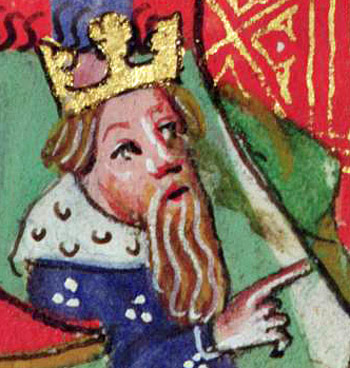Titus and Vespasian
General Information
Plot Summary

The poem opens with an account of Christ’s ministry and his persecution by the Jews, culminating in the Crucifixion. While he is in the tomb, Joseph of Arimethea is miraculously released from prison, but is recaptured after he begins to preach. After the Resurrection, Christ gives Jerusalem’s citizens forty years to repent: otherwise the destruction of their city will complete the Israelites’ three-fold punishment, adding dispersion to pilgrimage and servitude. Despite many strange portents, however, the Jews remain impenitent, martyring St James the Less as God prepares his vengeance.
Vespasian, King of Gascony and vassal of the Emperor Nero, suffers from leprosy and has a bee-hive in his nose. One day his son, Titus, intercepts a ship carrying tribute from Pilate, Governor of Judea, to Rome. When he asks for a cure for his father, the captain describes the healing miracles of Christ and continues on Pilate’s errand. The poet recounts Pilate’s life, from his beginnings as the illegitimate son of a Spanish king to his friendship with the tyrannical Herod.
The steward Velocian travels to Jerusalem, seeking Christ and a cure for Vespasian’s disease. He lodges with the Christian Jacob and meets Veronica, who possesses a cloth imprinted with Christ’s image (the Vernicle). She returns to Gascony with Velocian and Pope Clement explains Christianity to Vespasian who professes his faith, kisses the cloth, and is healed. He refuses, however, to be christened until he has avenged Christ’s death. Leaving Clement in charge of his country, he and his men depart for Jerusalem.
As they approach, Pilate gathers his supporters, including Herod’s son, Archelaus. On Easter day AD 34 the Romans surround the city, erecting siege engines and ingeniously filling a valley with water. Five years into the siege, Vespasian briefly travels to Rome when he succeeds Nero as Emperor, but returns soon afterwards. Meanwhile within Jerusalem, Jacob is imprisoned for advising Pilate to surrender, but is transported out of the city by an angel and joins the Romans. The Jews attempt to fight, but are forced back into the city where famine sets in. When a woman roasts her child, Pilate orders the people to eat their treasure but cannibalism soon becomes rife. The secretly Christian Josephus reports conditions to Jacob, but refuses to support the un-baptised Vespasian. .
After seven years, the Jews and Pilate finally surrender. Josephus flees, but eventually joins Vespasian and cures the sickly Titus. Vespasian releases the Christians, including Joseph of Arimathea, but has no mercy on the Jews. He sells them thirty for a penny to his men, who extract their treasure by torture. Titus destroys Jerusalem, leaving the survivors homeless until Doomsday. Pilate refuses to repent and kills himself in prison: his body turns both water and land noxious until it is miraculously enclosed in rock. The poem describes the life of another famous suicide, Judas, who became a disciple after accidentally killing his father and marrying his mother.
After conquering the other towns in Judea, Vespasian returns to Rome where he and all his men are christened. Temples are converted into churches, and the Vernicle is enshrined in St Peter’s, where Clement anoints Vespasian as Emperor. He rules well, and when he dies miracles occur at his tomb. When the Jews attempt to rebuild their city, they are destroyed by miraculous fire.
From: J. A. Herbert, ed.. Titus & Vespasian: or The Destruction of Jerusalem in Rhymed Couplets: Edited from the London and Oxford MSS. London: Roxburghe Club, 1905.
Manuscript: London, British Library, MS Additional 36523
Manuscripts
Click a title below to search for all romances in that manuscript.